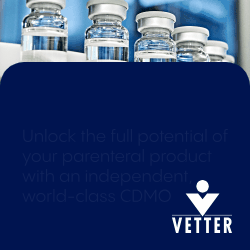Bio Platforms
Chugai and Gero Enter into Joint Research and License Agreement to Develop Novel Therapies for Age-Related Diseases
TOKYO, Chugai Pharmaceutical Co., Ltd., and Gero PTE. LTD. , a Singapore-based biotechnology company, announced today that they have entered into a joint research and…
Denali Therapeutics Announces FDA Acceptance and Priority Review of Biologics License Application (BLA) for Tividenofusp Alfa for Hunter Syndrome (MPS II)
SOUTH SAN FRANCISCO, Calif., Denali Therapeutics Inc. (Nasdaq: DNLI) today announced that the U.S. Food and Drug Administration (FDA) has accepted for review the Biologics…
LENZ Therapeutics and Laboratoires Théa Announce Exclusive License and Commercialization Agreement for LNZ100 in Canada
SAN DIEGO and CLERMONT-FERRAND, France, LENZ Therapeutics, Inc. (Nasdaq: LENZ) and Laboratoires Théa (“Théa”) announced an exclusive license and commercialization agreement for Théa to register…
Oxford BioTherapeutics Announces Third Oncology Drug Candidate from Boehringer Ingelheim Collaboration Selected to Advance into IND-Enabling Studies
Oxford, UK and San Jose, California, Oxford BioTherapeutics (OBT), a clinical stage oncology company with a pipeline of immuno-oncology (IO) and Antibody Drug Conjugate (ADC)-based therapies,…
Clearmind Medicine Announces IRB Approval for Phase 1/2a Clinical Trial for Alcohol Use Disorder at Tel Aviv Sourasky Medical Center
Vancouver, Canada, Clearmind Medicine Inc. (Nasdaq: CMND), (FSE: CWY0), a clinical-stage biotech company focused on discovery and development of novel psychedelic-derived therapeutics to solve major…
Cue Biopharma Provides Update on Most Advanced Clinical Stage Asset, CUE-101
BOSTON, Cue Biopharma, Inc. (Nasdaq: CUE), a clinical-stage biopharmaceutical company developing a novel class of therapeutic biologics to selectively engage and modulate disease-specific T cells for…
Belite Bio Announces Completion of Enrollment in the Pivotal Global Phase 3 PHOENIX Trial Evaluating Oral Tinlarebant in Geographic Atrophy
SAN DIEGO, - Belite Bio, Inc. (NASDAQ: BLTE), a clinical-stage drug development company focused on advancing novel therapeutics targeting degenerative retinal diseases that have significant…
Asahi Kasei Pharma starts Phase III study of promising CIPN prevention therapy, ART-123 (Recomodulin, to enhance treatment options worldwide
Chelmsford, MA; Novi, MI; Düsseldorf, Germany; and Tokyo, Japan - Asahi Kasei Pharma has started trial drug administration in a Phase III study of ART-123…
Aenova expands cold chain capabilities with new state-of-the-art warehouse at its sterile site in Latina
Latina (Italy), Aenova, a leading global contract development and manufacturing organization (CDMO), is investing in a new cold chain warehouse at its sterile site in…
PharmNovo announces CTA submission for lead candidate PN6047, a next generation selective Delta Opioid Receptor Agonist (DORA) for treatment of neuropathic pain
PN6047 is a first-in-class small molecule that selectively activates the delta opioid receptor (DOR), avoiding interaction with the mu opioid receptor that is the basis…
Genenta Announces Long-Term Follow-Up Observations in Brain Tumor (GBM) Study with Emerging Survival Signals
Genitourinary Tumor Study Ongoing with Active Screening and Enrollment MILAN and NEW YORK, Genenta Science (Nasdaq: GNTA), a pioneer in immuno-oncology, today announced that a…
atai Life Sciences Announces $50 Million Private Placement Financing
Financing co-led by Ferring Ventures S.A. and Apeiron Investment Ltd. with participation from new and existing healthcare-focused institutional investors, including Ally Bridge Group and ADAR1…
Apellis to Receive up to $300 Million from Royalty Purchase Agreement with Sobi for Ex-U.S. Royalties of Aspaveli (systemic pegcetacoplan)
Apellis to receive $275 million upfront and up to $25 million in milestone payments upon EMA approval in C3G and IC-MPGN Non-dilutive financing further…
Aptamer Group Identifies Novel Target to Enable Cell-Specific Gene Therapy for Liver Fibrosis
Aptamer unveils novel biomarker for targeted liver fibrosis therapy Optimer breakthrough targets liver scarring cells, positioning Aptamer in $20bn fibrosis market Aptamer Group plc today…
Allarity Therapeutics Announces Dosing of Second Patient in New Phase 2 Trial of Stenoparib in Advanced Ovarian Cancer
TARPON SPRINGS, Fla., Allarity Therapeutics, Inc. (NASDAQ: ALLR), a Phase 2 clinical-stage pharmaceutical company dedicated to developing stenoparib—a differentiated, dual PARP and WNT pathway inhibitor…
Opus Genetics Announces VEGA-3 Phase 3 Trial Met its Primary Endpoint for Phentolamine Ophthalmic Solution 0.75% for the Treatment of Presbyopia
RESEARCH TRIANGLE PARK, N.C., Opus Genetics, Inc. (Nasdaq: IRD), a clinical-stage biopharmaceutical company developing gene therapies for the treatment of inherited retinal diseases (IRDs) and…
Positive Top Line Results from Confirmatory Efficacy Study for Proposed Biosimilar to Xolair (omalizumab)
REYKJAVIK, Iceland and PISCATAWAY, N.J. and LONDON, Alvotech (NASDAQ: ALVO), a global biotech company specializing in the development and manufacturing of biosimilar medicines for patients…
Plus Therapeutics Announces FDA Clearance of its Investigational New Drug Application using REYOBIQTM for the Treatment of Childhood Brain Cancer
HOUSTON, Plus Therapeutics, Inc. (Nasdaq: PSTV), a clinical-stage pharmaceutical company developing targeted radiotherapeutics with advanced platform technologies for central nervous system (CNS) cancers, today announced…
Priothera Secures €1.7 million i-Nov Funding by Bpifrance for Rare Blood Cancer Clinical Program
Saint-Louis, France and Dublin, Ireland, Priothera, a late-stage biopharma company pioneering the development of mocravimod, a novel oral sphingosine 1 phosphate (S1P) receptor modulator, to treat…
Cue Biopharma Receives FDA Feedback on Pre-IND Briefing Document Reinforcing Company’s Intention to Advance IND Submission for CUE-401 to Address Unmet Need in the Treatment of Autoimmune Disease
BOSTON, Cue Biopharma, Inc. (Nasdaq: CUE), a clinical-stage biopharmaceutical company developing a novel class of therapeutic biologics to selectively engage and modulate disease-specific T cells for…
What are Bio Platforms?
Platforms (or asset-independent technologies to capture all kinds of capabilities that can be leveraged across many different drug candidate assets rather than just discovery tools that the term ‘platform’ immediately brings to mind) are ubiquitous in modern pharma. They are the product of an arms race, to secure access to the best capabilities in key areas.
Platform technologies are considered a valuable tool to improve efficiency and quality in drug product development. The basic idea is that a platform, in combination with a risk-based approach, is the most systematic method to leverage prior knowledge for a given new molecule. Furthermore, such a platform enables a continuous improvement by adding data for every new molecule developed by this approach, increasing the robustness of the platform.
But it has often been said that access to the latest technological platforms to aid efficient drug discovery and development is limited to Big Pharma, which can more easily justify the costs of creating and operating these platforms.
Benefits of Bio Platforms
Platform technologies have the ability to radically improve upon current products and generate completely novel products. In this sense, they open up new arenas for drug discovery and development, potentially increasing the number of therapeutic options for patients. Once a single compound or therapeutic has been generated and demonstrates a clinical benefit in patients, it is more likely this platform technology can successfully be applied to other therapeutic areas, derisking future compounds/products.
Complex drugs by their very nature are challenging and costly to manufacture. This, in turn, translates into higher costs for patients and other payers. In order to provide safe and effective therapies at a reasonable price, it is necessary for the industry to develop manufacturing technologies that reduce costs and provide a consistent product. While the initial investment may be larger, manufacturing costs will be lower over time as the manufacturing process is solidified.
Scale and Investment of Bio Platforms
Despite the initial upfront costs, platform technologies inevitably provide pragmatic solutions to production challenges, while yielding safer and more effective therapeutic products. It has often been said that one of the key features that distinguishes “Big Pharma” from biotech is access to the latest technological platforms to aid efficient drug discovery and development.
These platforms range from vast chemical libraries, ultra-high throughput screening and huge genetic databases in discovery, to predictive toxicology platforms, cutting-edge ‘omics’ and even deep-seated knowledge of particular therapeutic areas in development. All these platforms have two things in common: They can be used on any (or many) development candidate assets, and they cost huge sums to establish in the first place, and in a few cases each time they are used as well. Hence their restriction to the largest pharmaceutical companies (and a few of the so-called “big biotechs” that are, in many ways, indistinguishable from the old-guard pharma).
Only when you have hundreds of active projects can you justify the cost of creating and operating these platforms. Or so the mantra goes. It is access to these platforms that keeps the big companies ahead in the race to discover and develop the best medicines (or at least counterbalance the disadvantages of being large and slow-moving, depending on your point of view). But is that just an assertion? How much evidence is there to support the proposition that the efficiency gains due to these platforms outstrips the cost of creating and maintaining them?
Keeping these technologies “cutting edge” has become so expensive that increasingly we hear pharma companies talking of “pre-competitive” approaches to develop the next generation. A group of companies might develop a platform capability they then share. The principle goal of such initiatives is to access even grander and more expensive tools than individual companies could afford, rather than to dramatically cut costs (although sharing platforms rather than developing the same thing in parallel in each silo should at least keep a lid on rising costs).










